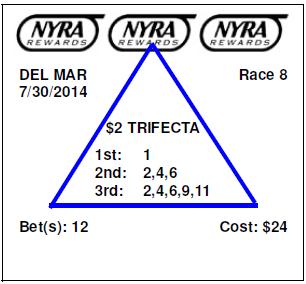Part Wheel Wagers – Pyramid Style
In a prior article we introduced the wager known as a Part-Wheel; and demonstrated how to use a Part-Wheel instead of Boxing horses in a Trifecta wager. Click here for a review of that article. Today we are going to expand on this type of wager, and provide some examples on how you might construct a bet using a Part Wheel Wager – Pyramid Style.
Let’s begin by explaining that a Part Wheel is a wager that is recognized by tellers at a race track. You would say a Part Wheel wager to a teller like this:
$2 Trifecta, Part Wheel, 2 with {4,6} with {4,6}. (This results in two Trifecta bets: 2,4,6 and 2,6,4)
This is a very simple example, but can be expanded to include much more sophisticated wagers.
Let’s create a race scenario with horse numbers, odds, and presumed handicapping thoughts. Let’s assume a 11-horse field with your list of contenders narrowed down to the following horses:
| Horse | Odds | Handicapping Thoughts |
|---|---|---|
| 1 | 2-1 | Your top selection, with high marks on Class, Distance, Form, and Pace. |
| 2 | 5-1 | Up and coming horse, improving with every start, but not quite up to the level of #1 yet. |
| 4 | 8-1 | Horse with past ability, off for 6-months, and workouts are solid. |
| 6 | 12-1 | Trainer statistics for this type of race show good percentage of horses hitting the board, but low win%. |
| 9 | 20-1 | Horse that rarely wins, but manages to finish 3rd from time-to-time at double digit odds. |
| 11 | 40-1 | Beyer Figs are well below the contenders, but with some improvement maybe good enough to hit the board. |
Using this information, you might construct a Trifecta Part-Wheel wager as follows:
$2 Trifecta, Part Wheel, 1 with {2,4,6} with {2,4,6,9,11}.
This results in 12 combinations: (1,2,4); (1,2,6); (1,2,9); (1,2,11); (1,4,2); (1,4,6); (1,4,9); (1,4,11); (1,6,2); (1,6,4); (1,6,9); and (1,6,11). These combinations will not print out on your ticket, but they are implied by the Part-Wheel wager. Below is what your ticket will look like.
In this example we are “keying” our top selection over other horses. If you were betting $2 Trifectas, this would result in 12 combinations times $2 per wager, for a total of $24 wagered.
So what happens if the #9 horse runs better than expected and finishes 2nd? Let’s say the results are 1-9-4. Unfortunately, our ticket does not win … because we required that 2,4,6 finish in 2nd place. Why would we have not used #9 and #11 in the second position? Simple answer: cost. Constructing a ticket of 1 with {2,4,6,9,11} with {2,4,6,9,11} would result in 20 combinations instead of 12. Causing our investment to nearly double from $24 to $40 in this example.
This begs the question, how do you know how many combinations are going to be in a Trifecta Part-Wheel wager? If your wager is constructed in a Pyramid Style where you are adding horses to each “leg” of the wager, the math is fairly simple for a 1-horse key wager like the one above.
Presume a Trifecta Part Wheel wager of: 1 with {A} with {B}.
Where {A} is the number of horses in the 2nd position and {B} is the number of horses in the 3rd position.
Presuming that {B} contains all of the horses in {A} plus some additional horses (like the above example) the mathematics would be:
1 x A x (B-1) = total number of combinations.
Here are some examples:
| Part Wheel Trifecta Wager | Math1 x A x (B-1) | Combinations | Cost (Presuming $2 wagers) |
|---|---|---|---|
| 1 with 2,4,6 with 2,4,6,9,11 | 1 x 3 x 4 | 12 | $24 |
| 1 with 2,4,6,9,11 with 2,4,6,9,11 | 1 x 5 x 4 | 20 | $40 |
| 1 with 2,4,6 with 2,4,6,8,9,11 | 1 x 3 x 5 | 15 | $30 |
| 1 with 2,4,6,8,9,11 with 2,4,6,8,9,11 | 1 x 6 x 5 | 30 | $60 |
From this example, you can see that your ticket cost can grow quite rapidly the more horses you add into the mix. This is why your handicapping is so important to allow you to construct affordable tickets. Regarding affordability, nearly all racetracks provide minimum Trifecta wagers of $1, and in some cases 50-cents. So the cost of the above tickets can be reduced to fit almost any budget.
Now keep in mind that the mathematics change when you use more than one horse in the win position. We’ll be covering that and also getting into more sophisticated Pyramid Style – Part Wheel wagers in the next article, including the mathematics for Superfecta tickets.



One comment on “Part Wheel Wagers – Pyramid Style”